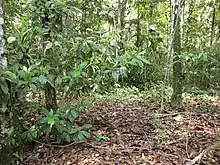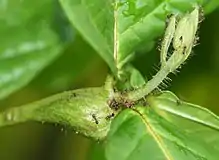Devil's garden
In myrmecology and forest ecology, a devil's garden (Kichwa: Supay chakra[1][2]) is a large stand of trees in the Amazon rainforest consisting of at most three tree species and the ant Myrmelachista schumanni.[2] Devil's gardens can reach up to sizes of 600 trees and are inhabited by a single ant colony, containing up to 3 million workers and 15,000 queens.[1][3] In a 2002 to 2004 census of the Amazon, devil's gardens were shown to have grown by 0.7 percent per year.[4] The relationship between tree and ant may persist for more than 800 years.[3][4] A devil's garden is considered an example of mutualism, a type of symbiotic relationship between species.

Background
Devil's gardens got their name because locals believed that an evil forest spirit Chullachaki (meaning "uneven foot, single foot" in Kichwa) or Chuyathaqi lived in them.[5][6]
Types
Inhabited by the ant Myrmelachista schumanni, devil's gardens, in different regions of the Amazon, can be dominated by different tree species.[1] In southeastern Peru, devil's gardens are dominated by Cordia nodosa (Boraginaceae) and occasionally mixed with Tococa occidentalis (Melastomataceae).[2][7] At higher elevations, the tree species Tapirira guianensis (Anacardiaceae) can be found dominating gardens.[2] In southeastern Ecuador and northeastern Peru the most common tree species found in devil's gardens are Duroia hirsuta (Rubiaceae).[2]
Symbiosis

The mutualistic symbiosis between the ant Myrmelachista schumanni and the tree Duroia hirsuta begins when an ant queen colonizes an isolated tree.[1] The ants make nesting sites in the hollow stems and leaves of the tree, called domatia.[4][7] The ants eliminate competition for the tree by poisoning all plants, except the host tree, with formic acid.[3] Because other plants are killed off, D. hirsuta saplings are able to grow and the ant colony is able to expand.[3][4]
The tree provides shelter (hollow stems and domatia) and food (leaves) for the ants,[7] and the ants provide a suitable environment for the trees to grow by eliminating competing plants.[7] Although the ants fend off herbivores, the size of the garden is restricted by leaf destruction increasing as it expands, as the ants are unable to defend the trees beyond a certain point.[1][6]
References
- Frederickson, M. E., & Gordon, D. (2007). The devil to pay: the cost of mutualism with Myrmelachista schumanni ants in 'devil's gardens' is increased herbivory on Duroia hirsuta trees. Proc. R. Soc. B. 274 (1613): 1117-23.
- David P. Edwards, Megan E. Frederickson, Glenn H. Shepard, and Douglas W. Yu (2009): A Plant Needs Ants like a Dog Needs Fleas: Myrmelachista schumanni Ants Gall Many Tree Species to Create Housing. The American Naturalist 174, no. 5: pp. 734-740.
- Frederickson, M. E., Greene, M. J., & Gordon, D. (2005). Ecology: 'Devil's gardens' bedevilled by ants. Nature 437: 495-6.
- Shwartz, Mark (2005-09-26). "Ants, not evil spirits, create poisonous devil's gardens in the Amazon rainforest". Stanford University. Retrieved 2019-12-03.
- Pablo Amaringo: Ayahuasca Visions - "a vision of the Supay-chacra or garden of the Chullachaki."
- BBC News: Devilish ants control the garden. 21 September 2005. Retrieved August 12, 2006.
- Morawetz, Wilfried; Henzl, Martin; Wallnöfer, Bruno (1992-03-01). "Tree killing by herbicide producing ants for the establishment of pureTococa occidentalis populations in the Peruvian Amazon". Biodiversity & Conservation. 1 (1): 19–33. doi:10.1007/BF00700248. ISSN 1572-9710.
